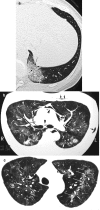SARS: radiological features
- PMID: 15018128
- PMCID: PMC7169195
- DOI: 10.1046/j.1440-1843.2003.00519.x
SARS: radiological features
Abstract
Air-space disease is typical in severe acute respiratory syndrome (SARS) and may be indistinguishable from pneumonia of other causes. In the majority of patients, ground glass opacities on chest radiographs progress rapidly to focal, multifocal or diffuse consolidation. Unilateral involvement is common in the early acute phase, becoming bilateral at maximal lung involvement. Generally, radiographic opacities peak between 8 and 10 days after onset of illness, with radiographic scores reflecting temporal changes in clinical and laboratory parameters such as oxygen saturation (SaO2) and liver transaminases. Pleural effusions, cavitating consolidation and mediastinal lymphadenopathy are not typical radiographic features. Pneumomediastinum and pneumothoraces are complications that are associated with extensive disease, with or without assisted ventilation. The utility of high resolution computed tomography (HRCT) and CT scans lies in the confirmation of airspace opacities in cases with normal initial chest radiographs that have strong contact history and signs and symptoms highly suspicious of SARS during the outbreak, allowing early treatment and prompt isolation. The characteristic HRCT feature in the acute phase is ground-glass opacities with smooth interlobular septal thickening, sometimes with consolidation in a subpleural location, which progress rapidly to involve other areas of the lungs. Temporal lung changes documented on HRCT suggest that some residual opacities found may not be reversible.
Figures



Similar articles
-
Comparison of initial high resolution computed tomography features in viral pneumonia between metapneumovirus infection and severe acute respiratory syndrome.Eur J Radiol. 2012 May;81(5):1083-7. doi: 10.1016/j.ejrad.2011.02.050. Epub 2011 Mar 25. Eur J Radiol. 2012. PMID: 21439753 Free PMC article.
-
Severe acute respiratory syndrome: temporal lung changes at thin-section CT in 30 patients.Radiology. 2004 Mar;230(3):836-44. doi: 10.1148/radiol.2303030853. Radiology. 2004. PMID: 14990845
-
Early X-ray and CT appearances of severe acute respiratory syndrome: an analysis of 28 cases.Chin Med J (Engl). 2003 Jun;116(6):823-6. Chin Med J (Engl). 2003. PMID: 12877787
-
Imaging of unusual diffuse lung diseases.Curr Opin Pulm Med. 2004 Sep;10(5):383-9. doi: 10.1097/01.mcp.0000134389.50775.b2. Curr Opin Pulm Med. 2004. PMID: 15316437 Review.
-
Radiologic pattern of disease in patients with severe acute respiratory syndrome: the Toronto experience.Radiographics. 2004 Mar-Apr;24(2):553-63. doi: 10.1148/rg.242035193. Radiographics. 2004. PMID: 15026600 Review.
Cited by
-
[COVID-19-associated lung weakness (CALW): Systematic review and meta-analysis].Med Intensiva. 2023 Apr 26. doi: 10.1016/j.medin.2023.04.010. Online ahead of print. Med Intensiva. 2023. PMID: 37359239 Free PMC article. Spanish.
-
Do COVID-19 CT features vary between patients from within and outside mainland China? Findings from a meta-analysis.Front Public Health. 2022 Oct 14;10:939095. doi: 10.3389/fpubh.2022.939095. eCollection 2022. Front Public Health. 2022. PMID: 36311632 Free PMC article.
-
[Radiological management and follow-up of post-COVID-19 patients].Radiologia. 2021 May-Jun;63(3):258-269. doi: 10.1016/j.rx.2021.02.003. Epub 2021 Feb 27. Radiologia. 2021. PMID: 35370314 Free PMC article. Spanish.
-
Pulmonary barotrauma in COVID-19: A systematic review and meta-analysis.Ann Med Surg (Lond). 2022 Jan;73:103221. doi: 10.1016/j.amsu.2021.103221. Epub 2022 Jan 3. Ann Med Surg (Lond). 2022. PMID: 35003730 Free PMC article. Review.
-
Eight months follow-up study on pulmonary function, lung radiographic, and related physiological characteristics in COVID-19 survivors.Sci Rep. 2021 Jul 5;11(1):13854. doi: 10.1038/s41598-021-93191-y. Sci Rep. 2021. PMID: 34226597 Free PMC article.
References
-
- Tsang KW, Ho PL, Ooi GC et al. A cluster of cases of severe acute respiratory syndrome in Hong Kong. N. Engl. J. Med. 2003; 348: 1977–85. - PubMed
-
- Lee N, Hui D, Wu A et al. A major outbreak of severe acute respiratory syndrome in Hong Kong. N. Engl. J. Med. 2003; 348: 1986–94. - PubMed
-
- World Health Organization. Case definitions for surveillance of severe acute respiratory syndrome (SARS). Revised May 1, 2003. [Cited 1 May, 2003.] Available from URL: http://www.who.int/csr/sars/casedefinition/en/
-
- Ksiazek TG, Erdman D, Goldsmith CS et al. A novel coronavirus associated with severe acute respiratory syndrome. N. Engl. J. Med. 2003; 348: 1953–66. - PubMed
Publication types
MeSH terms
LinkOut - more resources
Full Text Sources
Miscellaneous

